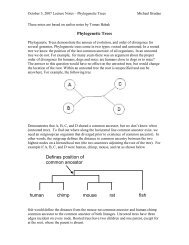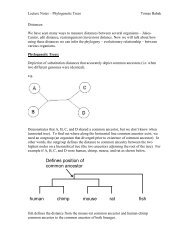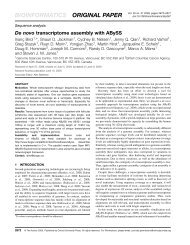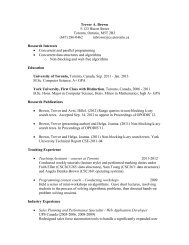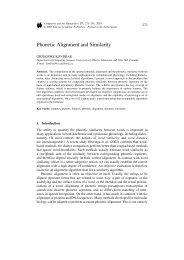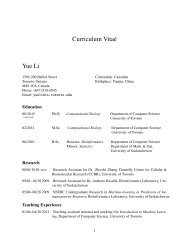Uli and Ted's slides (PDF, 1.0 Mb) - Department of Computer ...
Uli and Ted's slides (PDF, 1.0 Mb) - Department of Computer ...
Uli and Ted's slides (PDF, 1.0 Mb) - Department of Computer ...
Create successful ePaper yourself
Turn your PDF publications into a flip-book with our unique Google optimized e-Paper software.
Minimally Supervised Morphological<br />
Analysis by Multimodal Alignment<br />
by David Yarowski <strong>and</strong> Richard Wicentowski (ACL 2000)<br />
Presented by Ted Meeds <strong>and</strong> Ulrich Germann
David Yarowsky<br />
Currently pr<strong>of</strong>essor <strong>of</strong> CS at JHU.<br />
PhD University <strong>of</strong> Pennsylvania, 1996<br />
Research Interests: “natural language processing <strong>and</strong><br />
spoken language systems, machine translation,<br />
information retrieval, very large text databases <strong>and</strong><br />
machine learning”<br />
(from http://www.cs.jhu.edu/∼yarowsky/)<br />
Wicentowski’s thesis supervisor.
Richard Wicentowski<br />
Currently Pr<strong>of</strong>essor <strong>of</strong> <strong>Computer</strong> Science at Swarthmore<br />
College.<br />
PhD John Hopkins University, 2002<br />
Reseach Interests: computational morphology; word<br />
sense disambiguation.<br />
Work presented today is part <strong>of</strong> his PhD work.
What the paper is about...<br />
... an algorithm to build morphological analyzers with minimal<br />
supervision.<br />
Given<br />
an unannotated corpus in some language<br />
a-priori knowledge <strong>of</strong> the morphology <strong>of</strong> that language<br />
Perform the following:<br />
Build a probabilistic alignment <strong>of</strong> the word forms <strong>of</strong> that<br />
language.<br />
Use that alignment to learn (with supervision) a<br />
morphological analyzer.
In other words, build a table like this:<br />
from: Yarowsky & Wicentowski (2000)
Why Do We Care?<br />
Morphological analysis<br />
reduces vocabulary size, which means<br />
fewer dimensions in vector space models;<br />
higher data density (more counts <strong>of</strong> fewer event types)<br />
for model training.<br />
facilitates query expansion for IR.<br />
is necessary for dictionary lookup <strong>and</strong> indexing.<br />
...
Morphological Typology<br />
Isolating (analytic) languages.<br />
Agglutinative languages.<br />
Inflecting languages.<br />
Incorporating (polysynthetic) languages.<br />
Classification goes back to Schlegel (1818) <strong>and</strong> Humbold<br />
(1836).<br />
Natural Languages rarely fall exclusively into any one<br />
single category.
Isolating Languages<br />
Grammatical functions are expressed by independent<br />
units (words).<br />
Rule <strong>of</strong> thumb:<br />
# <strong>of</strong> morphemes<br />
# <strong>of</strong> words<br />
≈ 1.<br />
Prototypical examples: Vietnamese, Classical Chinese.
Agglutinative Languages<br />
Grammatical functions expressed by affixation.<br />
Rule <strong>of</strong> thumb: one grammatical or morphological feature<br />
per morpheme.<br />
E.g. Japanese hataraki.ta.gar.ana.kat.ta=kara:<br />
hataraki ta gar ana kat ta =kara<br />
“work” “want to” [apparently] “not” [morphol. ‘glue’] [PERF] “because”<br />
“Because [he/she/they] did not want to work ...”
Inflecting Languages<br />
One morpheme can express several morphological<br />
features, e.g. Latin:<br />
lauda (“praise”) + tur : 3rd person<br />
singular<br />
passive voice<br />
(present tense)
Incorporating (Polysynthetic) Languages<br />
“Words” are very complex, many features are<br />
“incorporated” into the verb, e.g. Yup’ik Inuit:<br />
tuntu ssur qatar ni ksaite ngqiggte uq<br />
reindeer hunt FUT say NEG again 3SG:IND<br />
’He had not yet said again that he was going to hunt reindeer.’<br />
Source: Eliza Orr, cited by T. Payne (1997): Describing morphosyntax: A guide for<br />
field linguists. Cambridge; New York: Cambridge University Press, p. 27-28. a<br />
Are such analyses using a useful notion <strong>of</strong> “word”?<br />
a http://www.sil.org/linguistics/GlossaryOfLinguisticTerms/WhatIsAPolysyntheticLanguage.htm
Means <strong>of</strong> Inflection <strong>and</strong> Derivation<br />
Affixation: call+s; call+ed; call+ing<br />
Circumfixation: steigen ⇒ stieg ⇒ ge · stieg · en<br />
Vowel Changes: take ⇒ took<br />
sleep ⇒ slep · t<br />
weep ⇒ wep · t<br />
Vocalization Patterns kataba — ‘he wrote’<br />
yaktubu — ‘he writes’<br />
kitāb — ‘book’<br />
Reduplication: paideu · omai ⇒ pe · paideu · ka
Concatenation — Assimilation — Fusion<br />
E.g. Japanese:<br />
Concatenation tabe + ta → tabe.ta<br />
Assimilation yari + ta → yat.ta<br />
Fusion kogi + ta → koida
Two-level Morphology (Koskenniemi, 1983)<br />
http://www.ling.helsinki.fi/ koskenni/esslli-2001-karttunen/<br />
Two levels <strong>of</strong> representation: Lexical level <strong>and</strong> surface<br />
level.<br />
Realization rules have access to both levels.<br />
Rules operate in parallel, not sequentially.
Two-level Morphology (cont’d)<br />
spy + s → spies<br />
Insert epenthetic ’e’ between [’y’ + morpheme boundary]<br />
<strong>and</strong> ’s’.<br />
lexical ’y’ → surface ’i’ before epenthetic ’e’.<br />
kaNpat → kammat<br />
’N’ → ’m’ before lexical ’p’.<br />
’p’ → ’m’ after surface ’m’.
Y & W’s General Approach<br />
Define probabilistic estimators that evaluate the<br />
probability that two word forms are different inflectional<br />
forms (e.g. PAST/PRESENT) <strong>of</strong> the same word.<br />
Use a combination <strong>of</strong> these estimators to align the word<br />
forms <strong>of</strong> a language in a probabilistic manner, maximizing<br />
the alignment probability under certain constraints (e.g.,<br />
pidgeon hole principle).<br />
This alignment can be used as input for a supervised<br />
morphological analysis learner.
Alignment by Frequency Similarity<br />
Intuition:<br />
The ratio <strong>of</strong> word form occurences, e.g. past tense<br />
forms vs. present tense forms is roughly the same<br />
across words.<br />
Consequence:<br />
We can use the ratios obtained by counting regular<br />
word forms in a corpus as estimates <strong>of</strong> the expected<br />
values for irregular word forms.
Alignment by Frequency Similarity<br />
Required:<br />
Procedure:<br />
Knowledge about regular morphology.<br />
A large corpus to obtain counts.<br />
Obtain counts for each pair <strong>of</strong> related regular<br />
forms (e.g. VBD/VB).<br />
Discretize count frequencies <strong>of</strong> log<br />
#V BD<br />
#V B<br />
values to<br />
obtain a histogram.<br />
Fit a curve to the histogram to obtain an estimated<br />
probability density function.
Alignment by Frequency Similarity<br />
from: Yarowsky & Wicentowski (2000)
Alignment by Frequency Similarity<br />
from: Yarowsky & Wicentowski (2000)
Alignment by Context Similarity<br />
Uses cosine between context vectors <strong>of</strong> word forms to<br />
measure their relatedness.<br />
Assumes that similarity is highest between different forms<br />
<strong>of</strong> the same word.<br />
Counting focusses on head nouns <strong>of</strong> objects <strong>and</strong> subjects<br />
<strong>of</strong> verbs.<br />
Uses regular expressions to obtain (very noisy!) counts<br />
— no parsing performed.<br />
CW subj (AUX|NEG)* V keyword DET? CW* CW obj<br />
Unlike frequency similarity, does not provide information<br />
about the exact nature <strong>of</strong> the relation between the two<br />
words.
Regular Expressions for Counts<br />
CW subj (AUX|NEG)* V keyword DET? CW* CW obj<br />
This paper presents an original <strong>and</strong> successful<br />
algorithm for ...
Alignment by Weighted Levenshtein Distance<br />
Levenshtein distance is an edit distance between a<br />
source <strong>and</strong> target word.<br />
Distance equal to the cost <strong>of</strong> inserting <strong>and</strong> deleting<br />
characters in source to produce target.<br />
Typically, cost (weights) <strong>of</strong> insertion or deletion is 1.<br />
Here author arbitrarily sets (initial) weights to reflect<br />
assumptions about the mutability <strong>of</strong> v to v, v to c, etc.<br />
Other suggested initializations: related languages <strong>and</strong><br />
phonetic similarities.
Cost Matrix<br />
δ1 = vowel ↔ vowel = 0.5<br />
δ2 = vowel cluster ↔ vowel cluster = 0.6<br />
δ3 = consonant ↔ consonant = <strong>1.0</strong><br />
δ4 = consonant ↔ vowel cluster = 0.98<br />
How were these values chosen? <strong>and</strong> how can the<br />
differences between δ1 / δ2 <strong>and</strong> δ3 / δ4 make a difference?<br />
Does it matter what we initialize with?
Cost Matrix, cont’d<br />
a o ue m n · · ·<br />
a 0 δ1 δ2 δ4 δ4 · · ·<br />
o δ1 0 δ2 δ4 δ4 · · ·<br />
ue δ2 δ2 0 δ4 δ4 · · ·<br />
m δ4 δ4 δ4 0 δ3 · · ·<br />
n δ4 δ4 δ4 δ3 0 · · ·<br />
· · · · · · · · · · · · · · · · · · · · ·
Cost Matrix Updates<br />
Cost matrix updated iteratively.<br />
Updates: character to character stem-change probs from<br />
current best alignments.<br />
No final cost matrix given. Number <strong>of</strong> iterations until<br />
convergence not given.
Alignment by Morphol. Transformation Probabilities<br />
Produces generative probabilistic model.<br />
Model: P ( inflection | root, suffix, POS )<br />
Knowing the stem change is equivalent to knowing the<br />
inflection.<br />
Model: P ( stem change | root, suffix, POS )
Alignment by Morphol. Transformation Probabilities<br />
Generate table with the counts <strong>of</strong> root contexts <strong>of</strong> various<br />
lengths <strong>and</strong> stem changes.<br />
E.g. solidify: ‘ify’, ‘fy’, ‘y’<br />
Notation: last3(solidify) =‘ify’<br />
root = γα, suffix = +σ, inflection = γβσ<br />
Model: P ( stem change | root, suffix, POS )<br />
Model: P (α → β|γα, +σ, P OS)
Sample Table<br />
Root<br />
Context<br />
Stem<br />
Change Suffix Count E.g.<br />
· · ·ify y→i +ed 23 solidify → solidified<br />
· · ·ify ɛ → ɛ +ing 65 solidify → solidifying<br />
· · ·fy y→i +ed 143 solidify → solidified<br />
· · ·fy ɛ → ɛ +ing 98 solidify → solidifying<br />
· · ·y y→i +ed 560 solidify → solidified<br />
· · ·y ɛ → ɛ +ing 435 solidify → solidifying
Iterpolated back<strong>of</strong>f model<br />
P (α → β|γα, +σ, P OS)<br />
= λ1P (α → β|last3(r), suf, P OS)<br />
+ (1 − λ1)λ2P (α → β|last2(r), suf, P OS)<br />
+ (1 − λ2)λ3P (α → β|last1(r), suf, P OS)<br />
+ (1 − λ3)λ4P (α → β|suf, P OS)<br />
+ (1 − λ4)P (α → β)<br />
Not limited to λ4, but how long are ‘very long root<br />
contexts’?
Initialization<br />
No inflection/root pairs exist at initialization.<br />
Initialize via Levenshtein, with geometric increase in cost<br />
from end <strong>of</strong> root.<br />
new cost = old * (1 + penalty)<br />
penalty = param * ( length(inflection) - position )<br />
Language dependent change in cost: English vs. Spanish
Parameter Re-estimation<br />
Training examples weighted by their ‘alignment<br />
confidence’??<br />
Must have minimal number <strong>of</strong> stem change/inflection<br />
pairs to keep in model.<br />
Final model:<br />
P (α → β|root, suffix , POS)<br />
= λjP0(α → β|suffix )<br />
+ (1 − λj)Pj(α → β|root, suffix , POS)<br />
Where j is really 1 → nbr root contexts?<br />
How are λ updated exactly?<br />
Same λ as before? Or a back<strong>of</strong>f model <strong>of</strong> a back<strong>of</strong>f<br />
model?
Evaluation<br />
from: Yarowsky & Wicentowski (2000)
Evaluation<br />
from: Yarowsky & Wicentowski (2000)
What I Like About This Paper<br />
Uses a combination <strong>of</strong> techniques.<br />
Doesn’t throw out Linguistics.<br />
Epistemological appeal: How much can we squeeze out<br />
<strong>of</strong> the data?
Concerns<br />
Is morphological analysis <strong>of</strong> irregular forms really an<br />
unsolved problem?<br />
The approach requires some morphological a-priori<br />
knowledge anyway, so we can’t do without a<br />
‘grammar’.<br />
Most grammars contain lists <strong>and</strong> rules for irregular<br />
morphological forms (e.g., list them as exceptions).<br />
Why not just hack them in <strong>and</strong> get on with life?<br />
Separation <strong>of</strong> training <strong>and</strong> testing data???<br />
Are we really achieving anything (beyond insight)?<br />
Do we really want to achieve anything, beyond insight?
Summary<br />
Y&W define four estimators that can estimate the<br />
probability that two word forms are related forms <strong>of</strong> the<br />
same word (e.g., PRESENT vs PAST).<br />
They view morphological analysis primarily as an<br />
alignment <strong>of</strong> the word form vocabulary <strong>of</strong> a large corpus.<br />
Their method achives an overall accuracy <strong>of</strong> 99.2%
“I have demonstrated the effectiveness <strong>of</strong> this<br />
analyzer in Spanish, Portuguese, French, Catalan,<br />
Occitan, Italian, Romanian, Latin, English, German,<br />
Dutch, Danish, Norwegian, Swedish, Icel<strong>and</strong>ic,<br />
Czech, Polish, Russian, Irish, Welsh, Greek, Hindi,<br />
Sanskrit, Estonian, Finnish, Turkish, Uzbek, Tamil,<br />
Basque, Tagalog, Swahili, <strong>and</strong> Klingon. In addition, I<br />
have done unpublished work in Amharic,<br />
Serbo-Croatian, Farsi, Arabic <strong>and</strong> Malay.”<br />
from Richard Wicentoski’s web page



